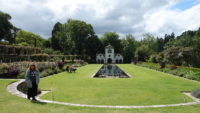 Many of my best vacation days come somewhat as a surprise. I either plan something that has more to it than I thought, or I don’t plan something and wing it and it turns out well (although it should be noted that sometimes improvised plans peter out) or locals tell me interesting things to do of which I was unaware. Today had examples of all three. Since it was Sunday, I wanted to go to church, but I also wanted to see some sights that had set closing hours. Ideally, I wanted an evening church service, but couldn’t find one in the area where we were staying. I did find an intriguing service at a tiny church up on the Great Orme, a very scenic hill above the town of Llandudno. Since I wanted to go up the Great Orme anyway, and the service started at 12:30 and gave me time to see Bodnant Gardens along the way, I added the church service to the day’s activities.
Many of my best vacation days come somewhat as a surprise. I either plan something that has more to it than I thought, or I don’t plan something and wing it and it turns out well (although it should be noted that sometimes improvised plans peter out) or locals tell me interesting things to do of which I was unaware. Today had examples of all three. Since it was Sunday, I wanted to go to church, but I also wanted to see some sights that had set closing hours. Ideally, I wanted an evening church service, but couldn’t find one in the area where we were staying. I did find an intriguing service at a tiny church up on the Great Orme, a very scenic hill above the town of Llandudno. Since I wanted to go up the Great Orme anyway, and the service started at 12:30 and gave me time to see Bodnant Gardens along the way, I added the church service to the day’s activities.
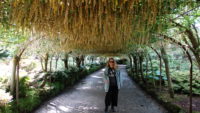 But first we stopped at the marvelous Bodnant Gardens a few miles south of Llandudno. I like large botanical gardens, and this one was set with the mountains in the background, so I knew I wanted to see it from early in my planning. Because of the church service, we would only have two hours at the garden, but I figured we could see a lot of the place in that time.
But first we stopped at the marvelous Bodnant Gardens a few miles south of Llandudno. I like large botanical gardens, and this one was set with the mountains in the background, so I knew I wanted to see it from early in my planning. Because of the church service, we would only have two hours at the garden, but I figured we could see a lot of the place in that time.
Not so much. The grounds are on eighty acres with dozens of interlacing paths and varying types of terrain. I wasn’t going to stress myself (not to mention Mer) by speed walking through the grounds just to say I had seen everything. We took it easy, and it was a very peaceful morning.
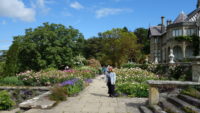 Since I knew we had limited time, we asked a docent (guide? gardener?) what to do. He said we had to start with the laburnum arch, which was a one-hundred-foot-long trellis with long yellow flowers hanging down. While not quite yet in full bloom, it was very pretty. The docent had told us to come back to him after the arch, which we duly did, and he directed us to the side of the house, where there were multiple stepped terraces, the first of which was covered in blooming roses. Mer and I were pleased – usually when we come across a rose garden, we’ve missed peak blooming, but this garden was resplendent.
Since I knew we had limited time, we asked a docent (guide? gardener?) what to do. He said we had to start with the laburnum arch, which was a one-hundred-foot-long trellis with long yellow flowers hanging down. While not quite yet in full bloom, it was very pretty. The docent had told us to come back to him after the arch, which we duly did, and he directed us to the side of the house, where there were multiple stepped terraces, the first of which was covered in blooming roses. Mer and I were pleased – usually when we come across a rose garden, we’ve missed peak blooming, but this garden was resplendent.
We found a secluded spot from which to admire the next terrace, which featured a pond between two huge old trees, and I reenacted a scene from Pride and Prejudice, one in which Mr. Darcy professes his love for Lizzy. When I finished, Mer was trying very hard not to laugh, and we both mentioned my libido-killing sun hat at the same time. She admitted that it was hard to take a passionate admission of love seriously when staring at that hat. It was still a pretty place.
 We dropped down to the last terrace, which had yet more roses and a very pretty reflecting pool showing off a handsome building (that used to be a pin factory) that the owner of the estate had bought and had moved to this terrace. Visually, it worked very well.
We dropped down to the last terrace, which had yet more roses and a very pretty reflecting pool showing off a handsome building (that used to be a pin factory) that the owner of the estate had bought and had moved to this terrace. Visually, it worked very well.
From there we wandered down to a stream where there was a small cafe, where we used the restroom. We also lavished fond attention on a kitty who was washing herself in the middle of an outdoor coffee table and seemed very comfortable with all the attention. Since we have been missing our own kitties, that was a welcome break.
We walked along the stream some, and then headed back up the hill through woods and a field and a small corner garden, before coming back to the house, which is still a private residence. We were not asked in for tea. Which was good, since we had to head on to St. Tudno’s Church on the Great Orme, a limestone headland at the end of the peninsular town Llandudno.
 I knew it was going to be very close, but had not realized just how steep and tight the roads were that went up onto the limestone hill, which I also had to share with trams hauling people up. I also had not realized how big the headland was – almost two miles long and one and a half miles wide. As such, after one wrong turn, I parked in the first parking pull-off I saw, and we walked down to St. Tudno’s. As such, we were about ten minutes late, but the people were very friendly and welcoming. There were maybe fifteen of us, with two lay women leading the outdoor service. The regular vicar was on vacation, and the fill-in had been in a minor accident, and so there was no priest. It felt like the story of St. Francis preaching to the birds. We had a seagull standing on a tombstone off to one side, and several sheep were grazing in the churchyard right behind us. It was fitting since it seems that this last week was some sort of UK celebration of the biodiversity of churchyards. The service focused on the hope we have in God, even in our dark times. It was special to worship in an intimate group, outside, and right next to a church that dated back to the 1500s (and there has been a church on site since about 600).
I knew it was going to be very close, but had not realized just how steep and tight the roads were that went up onto the limestone hill, which I also had to share with trams hauling people up. I also had not realized how big the headland was – almost two miles long and one and a half miles wide. As such, after one wrong turn, I parked in the first parking pull-off I saw, and we walked down to St. Tudno’s. As such, we were about ten minutes late, but the people were very friendly and welcoming. There were maybe fifteen of us, with two lay women leading the outdoor service. The regular vicar was on vacation, and the fill-in had been in a minor accident, and so there was no priest. It felt like the story of St. Francis preaching to the birds. We had a seagull standing on a tombstone off to one side, and several sheep were grazing in the churchyard right behind us. It was fitting since it seems that this last week was some sort of UK celebration of the biodiversity of churchyards. The service focused on the hope we have in God, even in our dark times. It was special to worship in an intimate group, outside, and right next to a church that dated back to the 1500s (and there has been a church on site since about 600).
After church, one of the lay women chatted with us and strongly recommended we take a scenic drive around the Great Orme, and even gave us tips on how to get to the mercifully one-way road around the back of the headlands (“If you stay really far right on the curve, you can probably make the hairpin turn in one go”). I love recommendations from locals, so I added that to the list.
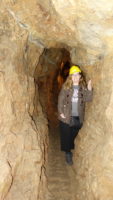 But first, we had to go underground. The entire reason we were in Llandudno was because I had stumbled across a mention of the Great Orme Copper Mine, which is a Bronze Age copper mine. We popped over and got our tickets. Bronze is an amalgam of copper and tin. This mine had tons and tons of copper (the largest Bronze Age mine yet found), but the nearest source of tin was three hundred miles away in Cornwall. Somehow they managed.
But first, we had to go underground. The entire reason we were in Llandudno was because I had stumbled across a mention of the Great Orme Copper Mine, which is a Bronze Age copper mine. We popped over and got our tickets. Bronze is an amalgam of copper and tin. This mine had tons and tons of copper (the largest Bronze Age mine yet found), but the nearest source of tin was three hundred miles away in Cornwall. Somehow they managed.
This mine was accidently discovered in the late 1980s as the land was being surveyed before being used for a car parking lot. There are miles of tunnels all dug using stones as hammers and bone tools as picks and chisels. Prior to the discovery of this mine, the conventional thinking was that the Romans brought metal-working to Britain around 40 AD. This mine dated to two thousand years before that, so it moved the timeline along a bit. Bronze that matches the product of the mine has been found as far away as Sweden, so some serious trading was going on.
 Of course we could go underground. The accessible tunnels were low and narrow, but passable. There were many tunnels in which the public isn’t allowed that were very small, and some exist that must have been carved by children because researchers can’t fit in them. The miners followed the softer copper minerals, so wherever the vein went was where the mine went. We were allowed on the first two levels of the mine, out of nine known levels (the lowest of which goes down to the water table, so they had to stop there because of flooding). There was one large cavern that had been dug out that is currently the largest Bronze Age manmade cave known (about the size of a very large classroom), and it had about a dozen tunnels leading away. It was a great tour, but the only thing I had planned for this town.
Of course we could go underground. The accessible tunnels were low and narrow, but passable. There were many tunnels in which the public isn’t allowed that were very small, and some exist that must have been carved by children because researchers can’t fit in them. The miners followed the softer copper minerals, so wherever the vein went was where the mine went. We were allowed on the first two levels of the mine, out of nine known levels (the lowest of which goes down to the water table, so they had to stop there because of flooding). There was one large cavern that had been dug out that is currently the largest Bronze Age manmade cave known (about the size of a very large classroom), and it had about a dozen tunnels leading away. It was a great tour, but the only thing I had planned for this town.
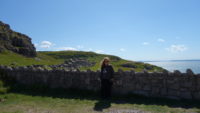 The scenic drive was not planned, but it was gorgeous. It gave great views of different parts of the headlands, as well as some overlooks of the mainland. We stopped at a cafe to grab something to eat just so we could linger in such a pretty spot. The scenic drive got us back to the west side of Llandudno, and we headed to our hotel.
The scenic drive was not planned, but it was gorgeous. It gave great views of different parts of the headlands, as well as some overlooks of the mainland. We stopped at a cafe to grab something to eat just so we could linger in such a pretty spot. The scenic drive got us back to the west side of Llandudno, and we headed to our hotel.
Llandudno, it turns out, is a vacation town for the British, like Blackpool. Our hotel overlooks part of a long pleasure pier, which includes a Ferris wheel. We got checked in, and then went up to a lookout point next to our hotel, which had a panorama of the town and far side of the bay area, as well as a view of the mountains to the southwest. We made our way down away from our hotel, which opened up close-up views of our side of the Great Orme. We eventually got down to the pier, of which we walked the length, which, if you remember that Wales has the second highest tides in the world after Australia, was no small thing. It’s a really, really long pier.
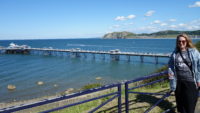 We walked part of the promenade with the ocean on one side and a solid wall of late 1800s hotels on the the other. We made our way away from the shore into the town, where we found an Italian restaurant and ate supper. Afterwards, I tried to do a couple of things that had caught my eye, but they had closed. So we wandered a bit at random again, until I saw a sign for the West Promenade. Since Llandudno is on the neck of a small peninsula, it has ocean on the east (the busy side) and the west (the windward side). We walked all the way out to the western side, and it was wonderful. The tourist trappings were all gone, but there was a long park and wide sidewalks all along the beach area. We watched several kitesurfers out on their boards, and we were impressed at their speed and flips and jumps (some of which let them hang in the air for five or six seconds). The mountains were in front of us, and the Great Orme was behind us. It was a lovely spot, if a bit breezy. We sat and strolled some for about thirty minutes before heading back to the hotel for the evening.
We walked part of the promenade with the ocean on one side and a solid wall of late 1800s hotels on the the other. We made our way away from the shore into the town, where we found an Italian restaurant and ate supper. Afterwards, I tried to do a couple of things that had caught my eye, but they had closed. So we wandered a bit at random again, until I saw a sign for the West Promenade. Since Llandudno is on the neck of a small peninsula, it has ocean on the east (the busy side) and the west (the windward side). We walked all the way out to the western side, and it was wonderful. The tourist trappings were all gone, but there was a long park and wide sidewalks all along the beach area. We watched several kitesurfers out on their boards, and we were impressed at their speed and flips and jumps (some of which let them hang in the air for five or six seconds). The mountains were in front of us, and the Great Orme was behind us. It was a lovely spot, if a bit breezy. We sat and strolled some for about thirty minutes before heading back to the hotel for the evening.
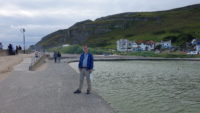 Touring, at least for me, takes some parts planning and some parts improvisation and a willingness to listen to locals. We’ll see what happens tomorrow, as we have our long six-hour drive up to Scotland to put us close to the airport for Tuesday morning. I haven’t planned anything yet. Let the magic happen.
Touring, at least for me, takes some parts planning and some parts improvisation and a willingness to listen to locals. We’ll see what happens tomorrow, as we have our long six-hour drive up to Scotland to put us close to the airport for Tuesday morning. I haven’t planned anything yet. Let the magic happen.
“… I reenacted a scene from Pride and Prejudice, where Mr. Darcy professes his love for Lizzy.”
You. Ruin. EVERYTHING.
Oh, believe me, it was ruined. Dumb hat.
Yeah. It was the hat that ruined it.